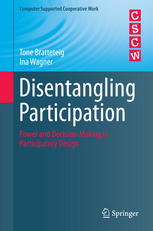

Most ebook files are in PDF format, so you can easily read them using various software such as Foxit Reader or directly on the Google Chrome browser.
Some ebook files are released by publishers in other formats such as .awz, .mobi, .epub, .fb2, etc. You may need to install specific software to read these formats on mobile/PC, such as Calibre.
Please read the tutorial at this link: https://ebookbell.com/faq
We offer FREE conversion to the popular formats you request; however, this may take some time. Therefore, right after payment, please email us, and we will try to provide the service as quickly as possible.
For some exceptional file formats or broken links (if any), please refrain from opening any disputes. Instead, email us first, and we will try to assist within a maximum of 6 hours.
EbookBell Team

4.0
96 reviewsProviding a critical view on user participation in design, disentangling decision making and power in design, this book uses fieldwork material from two large participatory design projects: one experimental in the field of urban planning, the other a product development project within health care. Addressing power issues in participatory design is critical to providing a realistic view of the possibilities and limitations of participation. Design is decision-making: during a design process a huge number of decisions taken before the designers end up with a design result - an artefact or system. All decisions are a choice between possibilities and selecting one of them and making it concrete as a change in an artefact is a demonstration of the capacity to transform, which is a key aspect of power. Participatory designers are committed to empowering users and facilitating a design process where users are able to take part in all types of decisions. This volume explores the challenges for practitioners of participatory design arising from this commitment by asking what participation really means: who should participate and in which parts of a design process; what does it mean to share power with users; how are decisions to be made in a participatory way and what is it that users participate in? The book provides a conceptual framework for understanding these issues as well as a fresh look at participation.